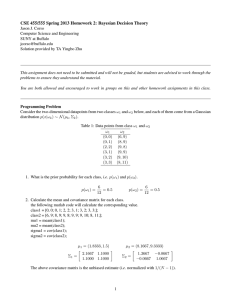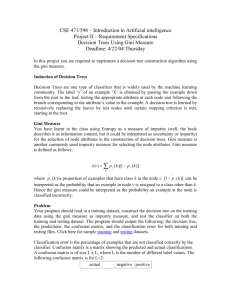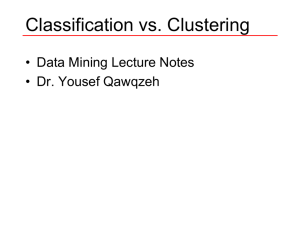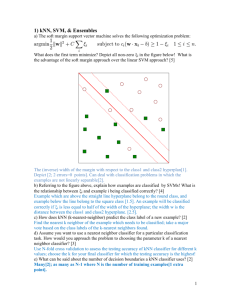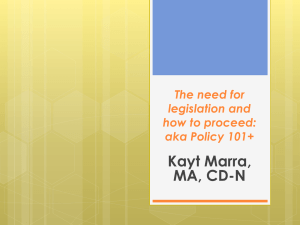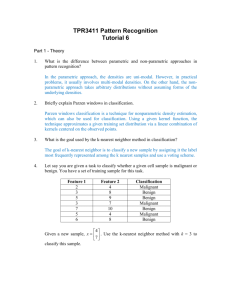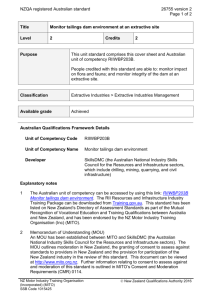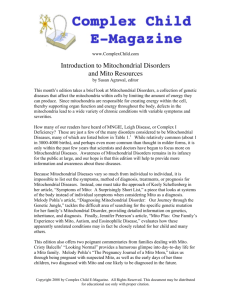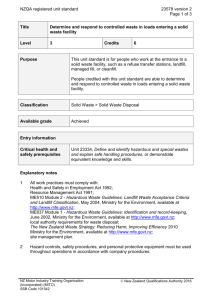Document 13591648
advertisement
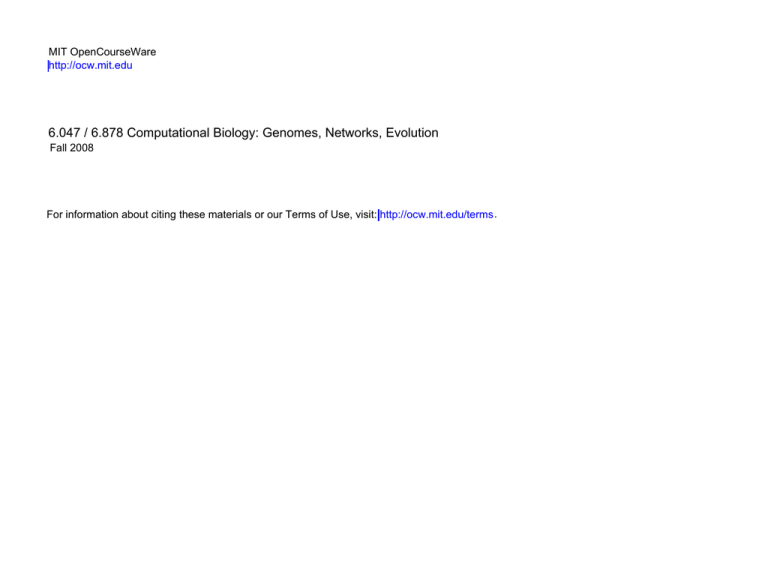
MIT OpenCourseWare http://ocw.mit.edu 6.047 / 6.878 Computational Biology: Genomes, Networks, Evolution Fall 2008 For information about citing these materials or our Terms of Use, visit: http://ocw.mit.edu/terms. Computational Biology: Genomes, Networks, Evolution Classification Lecture 5 September 18, 2008 Two Different Approaches • Generative – Bayesian Classification and Naïve Bayes – Example: Mitochondrial Protein Prediction • Discriminative – Support Vector Machines – Example: Tumor Classification Bayesian Classification We will pose the classification problem in probabilistic terms Create models for how features are distributed for objects of different classes We will use probability calculus to make classification decisions Classifying Mitochondrial Proteins Derive 7 features for all human proteins Targeting signal Protein domains Co-expression Mass Spec Homology Induction Motifs Predict nuclear encoded mitochondrial genes Maestro First page of article removed due to copyright restrictions: Calvo, S., et al. "Systematic Identification of Human Mitochondrial Disease Genes Through Integrative Genomics." Nature Genetics 38 (2006): 576-582. • Each object can be associated with multiple features • We will look at the case of just one feature for now Conservation Lets Look at Just One Feature Proteins Co-Expression We are going to define two key The First Key Concept Features for each class drawn from class-conditional probability distributions (CCPD) P(X|Class1) P(X|Class2) X Our first goal will be to model these distributions The Second Key Concept We model prior probabilities to quantify the expected a priori chance of seeing a class P(Class2) & P(Class1) P(mito) = how likely is the next protein to be a mitochondrial protein before I see any features to help me decide We expect ~1500 mitochondrial genes out of ~21000 total, so P(mito)=1500/21000 P(~mito)=19500/21000 But How Do We Classify? • So we have priors defining the a priori probability of a class P(Class1), P(Class2) • We also have models for the probability of a feature given each class P(X|Class1), P(X|Class2) But we want the probability of the class given a feature How do we get P(Class1|X)? Bayes Rule Evaluate evidence Belief before evidence P( Feature | Class) P(Class) P(Class | Feature) = P( Feature) Belief after evidence Evidence Bayes, Thomas (1763) An essay towards solving a problem in the doctrine of chances. Philosophical Transactions of the Royal Society of London, 53:370-418 Bayes Decision Rule If we observe an object with feature X, how do decide if the object is from Class 1? The Bayes Decision Rule is simply choose Class1 if: P (Class1| X ) > P (Class 2 | X ) P( X | Class1) P( L1) P( X | Class 2) P( L 2) > P( X ) P( X ) P( X This | Class P(Class > P( X |on Class 2) P (Class 2) is1) the same1)number both sides! Discriminant Function We can create a convenient representation of the Bayes Decision Rule P ( X | Class1) P(Class1) > P ( X | Class 2) P (Class 2) P ( X | Class1) P(Class1) >1 P ( X | Class 2) P (Class 2) G ( X ) = log P ( X | Class1) P (Class1) >0 P ( X | Class 2) P(Class 2) If G(X) > 0, we classify as Class 1 Stepping back What do we have so far? We have defined the two components, class-conditional distributions and priors P(X|Class1), P(X|Class2) P(Class1), P(Class2) We have used Bayes Rule to create a discriminant function for classification from these components G ( X ) = log P( X | Class1) P(Class1) >0 P ( X | Class 2) P (Class 2) Given a new feature, X, we plug it into this equation… …and if G(X)> 0 we classify as Class1 Two Fundamental Tasks • We need to estimate the needed probability distributions – P(X|Mito) and P(x|~Mito) – P(Mito) and P(~Mito) • We need to assess the accuracy of the classifier – How well does it classify new objects The All Important Training Set Building a classifier requires a set of labeled data points called the Training Set The quality of the classifier depends on the number of training set data points How many data points you need depends on the problem Need to build and test your classifier Getting P(X|Class) from Training Set P(X|Class1) How do we get this from these? There are 13 data points One Simple Approach Divide X values into bins And then we simply count frequencies In general, and especially for continuous distributions, this can be a complicated problem Density Estimation X 7/13 3/13 2/13 1/13 0 <1 1-3 3-5 5-7 >7 Getting Priors Three general approaches 1. 2. 3. Estimate priors by counting fraction of classes in training set Estimate from “expert” knowledge P(Class1)=13/23 P(Class2)=10/23 13 Class1 10 Class2 We have no idea – use equal (uninformative) priors But sometimes fractions in training set are not representative of world Example P(mito)=1500/21000 P(~mito)=19500/21000 P(Class1)=P(Class2) We Are Just About There…. We have created the class-conditional distributions and priors P(X|Class1), P(X|Class2) P(Class1), P(Class2) And we are ready to plug these into our discriminant function P ( X | Class1) P(Class1) G ( X ) = log >0 P ( X | Class 2) P(Class 2) But there is one more little complication….. But What About Multiple Features? Targeting signal • We have focused on a single feature for an object • But mitochondrial protein prediction (for example) has 7 features Protein domains Co-expression Mass Spec Homology Induction Motifs So P(X|Class) become P(X1,X2,X3,…,X8|Class) and our discriminant function becomes P( X 1 , X 2 ,..., X 7 | Class1) P (Class1) G ( X ) = log >0 P( X 1 , X 2 ,..., X 7 | Class 2) P(Class 2) Distributions Over Many Features Estimating P(X1,X2,X3,…,X8|Class1) can be difficult • Assume each feature binned into 5 possible values • We have 58 combinations of values we need to count the frequency for • Generally will not have enough data – We will have lots of nasty zeros Naïve Bayes Classifier We are going to make the following assumption: All features are independent given the class P( X 1 , X 2 ,..., X n | Class ) = P( X 1 | Class) P( X 2 | Class)...P( X n | Class ) n = ∏ P( X i | Class ) i =1 We can thus estimate individual distributions for each feature and just multiply them together! Naïve Bayes Discriminant Function Thus, with the Naïve Bayes assumption, we can now rewrite, this: G ( X 1 ,..., X 7 ) = log P ( X 1 , X 2 ,..., X 7 | Class1) P(Class1) >0 P ( X 1 , X 2 ,..., X 7 | Class 2) P(Class 2) As this: G ( X 1 ,..., X 7 P ( X | Class1) P (Class1) ∏ >0 ) = log ∏ P( X | Class 2) P(Class 2) i i Individual Feature Distributions Instead of a single big distribution, we have a smaller one for each feature (and class) P(Target|Mito) P(Target|~Mito) P(Domain|Mito) P(Domain|~Mito) Target 7/13 P(CE|Mito) P(CE|~Mito) 3/13 2/13 1/13 Targeting signal P(Mass|Mito) P(Mass|~Mito) P(Homology|Mito) P(Homology|~Mito) Protein domains P(Induc|Mito) P(Induc|~Mito) Co-expression P(Motif|Mito) P(Motif|~Mito) 0 <1 1-3 3-5 5-7 >7 Mass Spec Homology Induction Motifs Classifying A New Protein Targeting signal Protein domains Co-expression Xi Mass Spec Homology Induction P(Xi|Mito) P(Xi|~Mito) (for all 8 features) Motifs Plug these and priors into the discriminant function G ( X 1 ,..., X 7 P ( X | Mito) P ( Mito) ∏ ) = log >0 ∏ P( X |~ Mito) P(~ Mito) i i IF G>0, we predict that the protein is from class Mito Maestro Results Apply Maestro to Human Proteome Total predictions: 1,451 proteins 490 novel predictions Courtesy of Sarah Calvo. Used with permission. Slide Credit: S. Calvo How Good is the Classifier? The Rule We must test our classifier on a different set from the training set: the labeled test set The Task We will classify each object in the test set and count the number of each type of error Binary Classification Errors • True (Mito) False (~Mito) Predicted True TP FP Predicted False FN TN Sensitivity = TP/(TP+FN) Specificity = TN/(TN+FP) Sensitivity – Fraction of all Class1 (True) that we correctly predicted at Class 1 – How good are we at finding what we are looking for • Specificity – Fraction of all Class 2 (False) called Class 2 – How many of the Class 2 do we filter out of our Class 1 predictions In both cases, the higher the better Maestro Outperforms Existing Classifiers Naïve Bayes (Maestro) (99%, 71%) ** Courtesy of Sarah Calvo. Used with permission. Slide Credit: S. Calvo Support Vector Machines Discriminative Classification Support Vector Machines (SVMs) Easy to select a line But many lines will separate these training data What line should we choose? Support Vector Machines (SVMs) n r rgi ma arato sep rgin ma A sensible choice is to select a line that maximizes the margin between classes Support Vectors SVM Formulation n r rgi ma arato sep rgin ma We define a vector w normal to the separating line Labels Y=+1 Y=-1 w Assume all data satisfy the following: x i • w − b ≥ +1 for yi =+1 x i • w − b ≤ −1 for yi =-1 yi ( x i • w − b ≥ 1) xi•w b/|x| An Optimization Problem For full derivation, see Burges (1998) Only need dot product of input data! 1 Minimize L D = ∑ α i − ∑ α iα j yi y j x i • x j 2 i, j i subject to Solve for α ∑α y i i = 0 and α j > 0 Quadratic Programming i α i ( yi ( x i • w − b ) − 1) = 0 w = ∑ α i yi xi Only some αi are non-zero i xi with ai >0 are the support vectors w is determined by these data points! Using an SVM n r rgi ma arato sep rgin ma Given a new data point we simply assign it the label: Labels Y=+1 Y=-1 w yi = sign ( w • x new ) ⎛ ⎞ = sign ⎜ ∑ α i yi x i • x new ⎟ ⎝ i ⎠ b/|x| Again, only dot product of input data! xne Non-linear Classifier • Some data not linearly separable in low dimensions • What if we transform it to a higher dimension? 1 dimensional data 2 dimensional data 0.9 1 0.8 0.8 Kernel function 0.6 0.7 0.4 X2 0.2 0.6 0.5 0 0.4 -0.2 0.3 -0.4 0.2 -0.6 0.1 -0.8 -1 -1 -0.8 -0.6 -0.4 -0.2 0 0.2 0.4 0.6 0.8 1 0 -1 -0.8 -0.6 -0.4 -0.2 0 0.2 0.4 0.6 0.8 1 Noble, 2006. NATURE BIOTECHNOLOGY 24:1565. Kernel Mapping Want a mapping from input space to other euclidean space Φ(x): Rd -> Η But Φ(X) can be a mapping to an infinite dimensional space i.e. d points become an infinite number of points X=(x1,x2) Φ(X)=(φ1,φ2,φ3,….φ∞) Rather difficult to work with! Kernel Mapping Want a mapping from input space to other euclidean space Φ(x): Rd -> Η From previous slide, SVMs only depend on dot product Xi • Xj becomes Φ(Xi) • Φ(Xj) Here is trick: if we have a kernel function such that K(Xi,Xj) = Φ(Xi) • Φ(Xj) We can just use K and never know Φ(x) explicitly! Φ(X) is high dimensional K is a scalar Kernels So the key step is to take your input data and transform it into a kernel matrix Φ(xi) • Φ(xj) = scalar! 1 2 xi=(1,2) 2 1 2 N 1 K(Xi,Xj) We have then done two very useful things: 1. Transformed X into a high (possibly infinite) dimensional space (where we hope are data are separable) 2. Taken dot products in this space to create scalars N Example Kernels K ( xi ,x j ) = xiT x j K ( x i ,x j ) = ( γ x x j + r ) T i Linear d ( K ( xi ,x j ) = exp −γ xi − x j K ( xi ,x j ) = tanh ( γ xiT x j + r ) Polynomial 2 ) Radial Basis Function Sigmoid What K(Xi,Xj) are valid kernels? Answer given by Mercer’s Condition (see Burgess 1998) Using (Non-Linear) SVMs Step 1 – Transform data to Kernel Matrix K 1 2 N 1 2 N K(Xi,Xj) Step 2 – Train SVM on transformed data – get support vectors Minimize L D = ∑ α i − i 1 1 α α y y x • x = α − α iα j yi y j K ( x i , x j ) ∑ i j i j i j ∑i i 2 ∑ 2 i, j i, j Step 2 – Test/Classify on new samples ⎛ ⎞ ⎛ ⎞ ynew = sign ( w • x new ) = sign ⎜ ∑ α i yi x i • x new ⎟ = sign ⎜ ∑ α i yi K ( x i , x new ) ⎟ ⎝ i ⎠ ⎝ i ⎠ Classifying Tumors with Array Data • Primary samples: – 38 bone marrow samples – 27 ALL, 11 AML – obtained from acute leukemia patients at the time of diagnosis; • Independent samples: – 34 leukemia samples – 24 bone marrow – 10 peripheral blood samples • Assay ~6800 Genes Image removed due to copyright restrictions: title and abstract of Golub, T.R., et al. "Molecular Classification of Cancer: Class Discovery and Class Prediction by Gene Expression Monitoring." Science 286 (1999): 531-537. Figure 3b and supplementary figure 2 also removed from later pages. Weighted Voting Classfication General approach of Golub et al (1999) paper: – Choosing a set of informative genes based on their correlation with the class distinction – Each informative gene casts a weighted vote for one of the classes – Summing up the votes to determine the winning class and the prediction strength Results Initial Samples • 36 of the 38 samples as either AML or ALL. All 36 samples agree with clinical diagnosis • 2 not predicted Independent Samples • 29 of 34 samples are strongly predicted with 100% accuracy. • 5 not predicted Bringing Clustering and Classification Together Semi-Supervised Learning Common Scenario • Few labeled • Many unlabeled • Structured data What if we cluster first? Then clusters can help us classify

